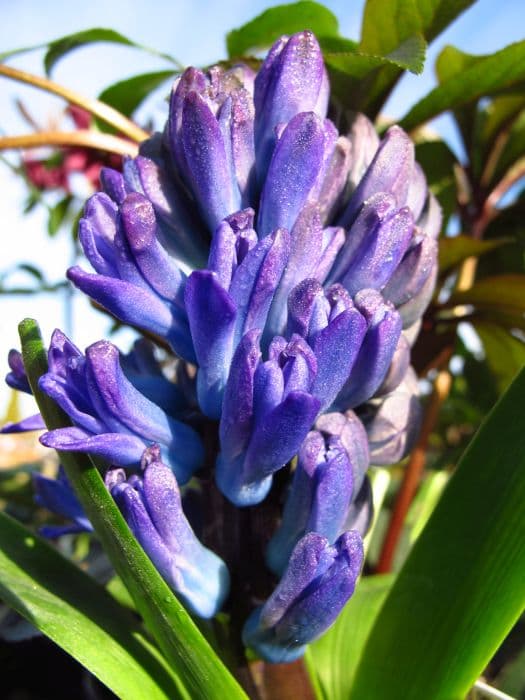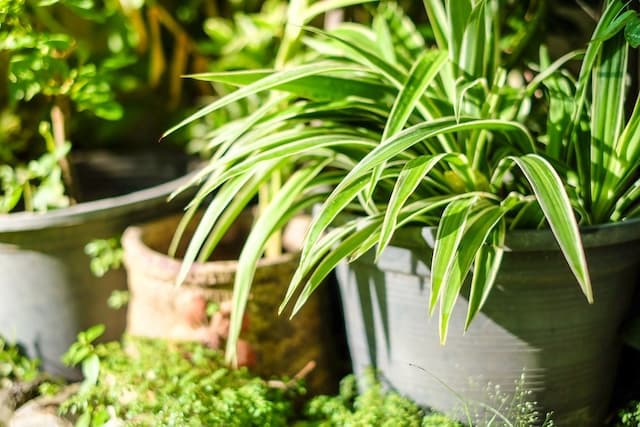Song of India Dracaena reflexa 'Variegata' (v)

ABOUT
Dracaena reflexa 'Variegata,' commonly known as variegated song of India, is a visually striking houseplant. This cultivar is characterized by its shiny leaves that have a leathery texture and an oval to lance shape. It is the variegation of the foliage that really makes it stand out, with leaves displaying a combination of green centers surrounded by creamy yellow to white edges, which can occasionally be tinged with pink. The leaves are spirally arranged and may grow from the plant's woody stems in tight whorls, giving the plant a dense and bushy appearance. As the variegated song of India matures, its stems can become quite thick, providing a strong structural element to the plant's shape. The contrast between the variegated leaves and the green stems creates a lively and vibrant look, which is why it is often favored for adding a touch of the tropics to indoor spaces.
About this plant
 Names
NamesFamily
Asparagaceae
Synonyms
Song of India, Variegated Dracaena, Variegated Pleomele, Striped Dracaena
Common names
Pleomele reflexa 'Variegata', Dracaena reflexa var. angustifolia 'Variegata'.
 Toxicity
ToxicityTo humans
The Song of Jamaica plant is generally not toxic to humans. If ingested, it can cause mild stomach upset, but it is not considered to be poisonous. It is always best to keep plants out of reach of small children who may chew on leaves or stems.
To pets
The Song of Jamaica plant is toxic to cats and dogs. If pets ingest this plant, they may experience symptoms such as vomiting, excessive drooling, weakness, loss of appetite, and depression. It can also cause dilated pupils in cats. Ingesting this plant can lead to serious health issues for your pets, so it is important to prevent access to it and seek veterinary care if you suspect your pet has consumed any part of it.
 Characteristics
CharacteristicsLife cycle
Perennials
Foliage type
Evergreen
Color of leaves
Variegated
Height
5 feet (1.52 meters)
Spread
3 feet (0.91 meters)
Plant type
Shrub
Hardiness zones
10
Native area
Madagascar
Benefits
 General Benefits
General Benefits- Easy Maintenance: Tolerant to neglect, requiring minimal watering and can thrive in a range of light conditions.
- Attractive Foliage: Features striking green leaves with creamy white or yellow edges, adding visual interest to any room.
- Adaptability: Can be grown in various environments, from indoor pots to outdoor landscapes in suitable climates.
- Longevity: Known for its long lifespan, ensuring a lasting presence in your home or garden with proper care.
- Growth Control: Its growth can be easily controlled with pruning, making it suitable for spaces of all sizes.
- Non-Toxic to Pets: Recognized as non-toxic to cats and dogs, making it a safe choice for pet owners.
- Stress Reduction: Presence of a living plant like Song of India can contribute to a feeling of well-being, reducing stress and promoting relaxation.
 Medical Properties
Medical PropertiesThis plant is not used for medical purposes.
 Air-purifying Qualities
Air-purifying QualitiesThis plant is not specifically known for air purifying qualities.
 Other Uses
Other Uses- Dracaena reflexa 'Variegata', commonly known as variegated song of India, can be used in terrariums as a feature plant due to its vibrant leaf coloring and ability to thrive in humid environments.
- Its striking striped leaves can be used as natural art elements in modern interior design, offering a contrasting visual against plain walls without consuming too much space.
- In photography, variegated song of India serves as a photogenic subject or as a green backdrop for portraits, enhancing the composition with its foliage pattern.
- This plant is sometimes used in Feng Shui practices, placed in specific areas of a home or office, believed to balance energies and bring a sense of harmony.
- It can be creatively included in floral arrangements or as a part of living table centerpieces for events, providing a unique and long-lasting decoration element.
- Variegated song of India's stems and leaves can be used in crafting, such as making bookmarks or incorporated into handmade paper for a botanical touch.
- The slow growth habit and minimal root system make it suitable for use in miniature gardens or fairy gardens, adding a touch of variegation to the landscape.
- This plant can be used as a natural dye source, where its leaves might be boiled to extract colors for fabrics or art projects.
- In ceremonial uses, some cultures might incorporate variegated song of India into wreaths or garlands for celebrations or as a symbol of prosperity.
- Instructional use in schools for botany or horticulture classes as a live example to teach plant care, propagation, and identification of variegated plants.
Interesting Facts
 Feng Shui
Feng ShuiThe Song of India is commonly used to improve indoor air quality, which is highly valued in Feng Shui as clean air contributes to good Chi energy flow. Place the Song of India in areas of your home or office where you want to foster growth and vitality, often in the east sector for health or southeast for wealth and abundance.
 Zodiac Sign Compitability
Zodiac Sign CompitabilityThe Song of India is not used in astrology practice.
 Plant Symbolism
Plant Symbolism- Longevity: The Dracaena reflexa 'Variegata', commonly known as Song of India, is known to be a hardy plant that can live for many years, symbolizing the ability to withstand the test of time.
- Purity: With its variegated leaves containing streaks of white, it is often associated with purity and cleansing of negative energies.
- Prosperity: In some cultures, having a Song of India plant in the home or office is believed to bring prosperity and good fortune.
 Water
WaterSong of India plants prefer the soil to be kept evenly moist, but not soggy. Water the plant when the top inch of soil feels dry to the touch, which is typically every 1 to 2 weeks, depending on the humidity and light conditions of the environment. Use room temperature water and pour it evenly around the base of the plant until water runs through the drainage holes. For an average-sized plant in a 10-inch pot, use about 16 to 32 ounces of water at each watering session to ensure the soil is thoroughly moistened.
 Light
LightSong of India plants thrive best in bright, indirect light. They can tolerate some partial shade but do not do well in direct sunlight, which can scorch their leaves. A spot near an east or north-facing window is ideal, where the plant can enjoy plenty of light without the harsh rays of the afternoon sun.
 Temperature
TemperatureSong of India plants prefer temperatures between 65°F and 75°F and can withstand a minimum temperature of 50°F. They do well in average room temperatures and should be protected from sudden drafts or cold, as temperatures below 50°F can cause damage to the plant.
 Pruning
PruningPruning your Song of India plant helps to maintain its size and shape, and encourages denser foliage. Prune in the spring or early summer by cutting back leggy stems or any yellowing leaves. Prune no more than one-third of the plant at a time to avoid stressing the plant too much.
 Cleaning
CleaningAs needed
 Soil
SoilThe Song of India plant prefers a well-draining potting mix with a substantial amount of perlite or sand to enhance drainage. Organic matter such as peat or pine bark will help retain moisture while providing aeration. The best soil pH for this plant is between 6.0 and 6.5, slightly acidic.
 Repotting
RepottingThe Song of India plant should be repotted every 2-3 years or when it becomes root-bound. It's important to use a fresh soil mix and a pot that is one size larger than the current one.
 Humidity & Misting
Humidity & MistingThe Song of India thrives in moderate to high humidity levels, ideally between 40% and 60%. If the air is too dry, the plant's leaf tips may turn brown.
 Suitable locations
Suitable locationsIndoor
Place in indirect light, keep soil slightly moist.
Outdoor
Partial shade; protect from frost.
Hardiness zone
10-12 USDA
 Life cycle
Life cycleDracaena reflexa 'Variegata', commonly known as the Song of India, begins its life as a seed, which upon germination grows into a seedling with embryonic leaves. As it enters the vegetative stage, the plant develops its characteristic variegated leaves—elongated, green with yellow or light green stripes—and begins to grow in height and width. The Song of India is a slow-grower, taking several years to reach maturity at which point it may produce small white or yellowish flowers, although flowering is rare when grown indoors. After flowering, the plant may produce small berries containing seeds, continuing its reproductive cycle, but this is infrequently seen in domestic settings. In its mature phase, the plant can focus on thickening its woody stems and maintaining its dense foliage. Over the years, if the plant's conditions are suboptimal or it contracts a disease, it may enter a period of decline, which can be mitigated with good care practices such as adequate watering, proper lighting, and regular fertilization.
 Propogation
PropogationPropogation time
Spring to Summer
Propogation: The Song of India plant, commonly known as Dracaena reflexa 'Variegata', can be propagated typically during the warmer months of spring and summer when the plant is actively growing. Stem cuttings are the most popular method of propagating this ornamental plant. To propagate by stem cuttings, select a healthy, non-flowering stem of about 4 to 6 inches (10 to 15 centimeters) long. Cut just below a leaf node, where there is a concentration of hormones to stimulate root growth. Remove the lower leaves and allow the cutting to dry for a few hours to form a callus over the cut surface, which helps prevent rot. Then, insert the cutting into a pot filled with a mixture of peat and perlite or sand, ensuring at least one node is buried where roots can develop. Keep the soil lightly moist and the cutting in warm, indirect light until roots have established, which can take several weeks.









